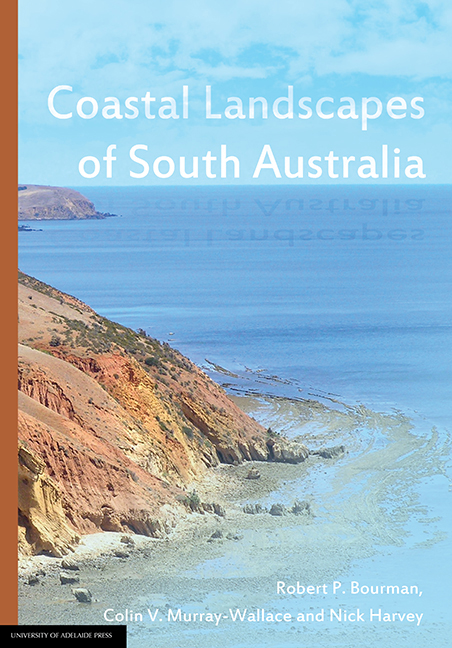Book contents
- Frontmatter
- Dedication
- Contents
- Preface
- Biographies
- Acknowledgements
- 1 Coastal landscapes of South Australia
- 2 The coast of metropolitan Adelaide
- 3 The Fleurieu Peninsula coast
- 4 The River Murray Estuary
- 5 The Coorong Coastal Plain and the Limestone Coast
- 6 The northern Gulf St Vincent tidal coastline (the Samphire Coast)
- 7 The Yorke Peninsula coastline
- 8 The northern Spencer Gulf coast
- 9 The Gulf Coast of Eyre Peninsula
- 10 The Bight Coast - West coast of Eyre Peninsula
- 11 Kangaroo Island
- 12 Explaining the coastal landscapes of South Australia - A synthesis
3 - The Fleurieu Peninsula coast
Published online by Cambridge University Press: 25 July 2017
- Frontmatter
- Dedication
- Contents
- Preface
- Biographies
- Acknowledgements
- 1 Coastal landscapes of South Australia
- 2 The coast of metropolitan Adelaide
- 3 The Fleurieu Peninsula coast
- 4 The River Murray Estuary
- 5 The Coorong Coastal Plain and the Limestone Coast
- 6 The northern Gulf St Vincent tidal coastline (the Samphire Coast)
- 7 The Yorke Peninsula coastline
- 8 The northern Spencer Gulf coast
- 9 The Gulf Coast of Eyre Peninsula
- 10 The Bight Coast - West coast of Eyre Peninsula
- 11 Kangaroo Island
- 12 Explaining the coastal landscapes of South Australia - A synthesis
Summary
Introduction
Fleurieu Peninsula, the smallest of South Australia's three main peninsulas, was named by Nicolas Baudin in 1802 after Captain Charles Pierre Claret de Fleurieu, a Member of the Institute of France, which promoted Baudin's expedition. The Fleurieu coast, which extends about 140 km from Sellicks Beach in the north to Middleton in the southeast (Figure 3.1), is bedrock-dominated and exhibits cliffs, bluffs, rocky islands, shore platforms and reefs; sandy pocket beaches occupy small bays where valleys intersect the coast. More extensive beaches at Normanville, Tunkalilla and Victor Harbor front last interglacial embayments, formed when sea level was about 2 m higher than present. Vast arrays of geological features, past ice ages, climatic changes, prior shoreline positions and erosional and depositional stream activities have impacted on the coast.
Geological evolution
Part of the South Mount Lofty Ranges, Fleurieu Peninsula is underlain by resistant, folded rocks and granite intrusions, now exposed at the coast due to progressive tectonic uplift and erosion (Figure 3.2). During the Early Permian (299 to 290 Ma), an ice sheet some 1000 to 2000 m thick covered Fleurieu Peninsula, travelling towards the northwest. The ice sheet aided exposure of the Encounter Bay Granites, produced the present distribution of granite headland and islands of Encounter Bay, eroded deep valleys such as Backstairs Passage and deposited great thicknesses of glacial sediments, which today provide sand sources for many beaches.
Throughout the Mesozoic (253 to 66 Ma), Fleurieu Peninsula was exposed to continual weathering and erosion. After the separation of Australia and Antarctica, various marine incursions invaded the Paleogene and Neogene (65 to 2.6 Ma) basins fringing Fleurieu Peninsula and partially re-excavated Permian valleys within the ranges. Progressive tectonic uplift of Fleurieu Peninsula is revealed by the offset of these Cenozoic marine sediments. In the Myponga Basin, limestone 20 Ma old occurs at up to 240 m APSL, while at Sellicks Beach, only 12 km away, it extends below sea level. Active tectonism has uplifted the peninsula largely as a single tectonic block, tilted slightly to the south and exposing resistant bedrock at the coast to initiate and maintain the rugged, cliffed Fleurieu coast.
- Type
- Chapter
- Information
- Coastal Landscapes of South Australia , pp. 71 - 108Publisher: The University of Adelaide PressPrint publication year: 2016



